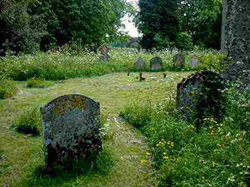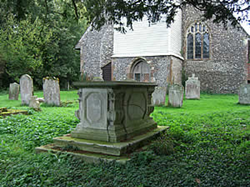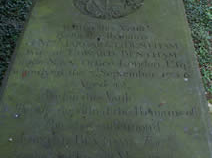Churchyard
he only feature of Doddington churchyard to have attracted the interest of historians was a remarkable ancient yew tree that was still growing there at the beginning of the eighteenth century. another of the parson-scholars who visited Doddington in times past, the Rev. John Harris, D.D. and F.R.S, described it in his 'History of Kent' (Vol I p.100) in 1719, as follows :
"In the Church-yard are three Yew Trees; out of the body of which grow a dozen, or more, of the large arms of a poplar tree; whose spreading branches compose almost all the lower part of this oddly double tree; the yew appearing above in the upper part of it; so that it hath a body and top of yew; but most of the lower and middle branches are of the white poplar; it seems to have come into this state from some accidental conveyance of the poplar seeds into its hollow body (perhaps by the means of the birds dropping them there) where meeting with some old rotten sullage or earth they took root and grew"
The churchyard also contains the fine eighteenth-century tomb of Edward Bentham of the Navy Office, London. His connection with the parish was not known until information contributed by Jeremy Greenwood October 2007 as follows:
" Will of Edward Bentham, of the Navy Office London 20 May 1774 PROB 11/997
He was Chief Clerk in the Ticket Office (Pay Office) and was the son (born 1714) of Brian Bentham, Clerk of the Cheque at Sheerness.
the connection is;
Nicholas Adye, esq. the third son, succeeded to Downe-court, and married Jane, daughter of Edward Desbouverie, esq. Their eldest son, John Adye, succeeded to this manor, at which he resided till he removed to Beakesborne, at the latter end of Charles II.'s reign, about which time he seems to have alienated it to Creed, of Charing, in which name it continued till it was sold to Bryan Bentham, esq. of Sheerness, who devised it to his eldest son Edward Bentham, esq. of the Navy-office, Since his death this estate has by his will become vested in trustees, to fulfil the purposes of it.
From: 'Parishes: Doddington', The History and Topographical Survey of the County of Kent: Volume 6 (1798), pp. 307-16. URL: http://www.british-history.ac.uk/report.asp?compid=62972&strquery=Bentham"


